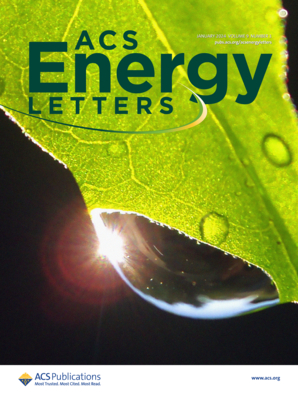Tracking Local pH Dynamics during Water Electrolysis via In-Line Continuous Flow Raman Spectroscopy
IF 19.3
1区 材料科学
Q1 CHEMISTRY, PHYSICAL
引用次数: 0
Abstract
The performance of electrochemical devices, which play a critical role in decarbonization efforts, is often governed by proton-coupled electron transfer reactions at the electrode–electrolyte interface. These reactions are highly sensitive to the complex and dynamic microenvironment present at the electrode surface. However, characterizing this environment─particularly monitoring interfacial pH and its evolution under reaction conditions─remains challenging, necessitating the development of advanced analytical tools. Here, we introduce in-line continuous flow Raman spectroscopy (CFRS) as a spectroelectrochemical platform for quantifying interfacial pH swings generated during water-splitting. By monitoring phosphate ion speciation and controlling the hydrodynamics with a flow cell, we measure pH swings as a function of current density, flow rate, and distance from the electrode. Comparison with theoretical models reveals the impact of bulk pH, boundary layer thickness, and bubble dynamics at high current densities. Collectively, these findings establish CFRS as a platform for quantitatively investigating pH dynamics, offering critical insights for advancing electrochemical energy conversion technologies.

求助全文
约1分钟内获得全文
求助全文
来源期刊

ACS Energy Letters
Energy-Renewable Energy, Sustainability and the Environment
CiteScore
31.20
自引率
5.00%
发文量
469
审稿时长
1 months
期刊介绍:
ACS Energy Letters is a monthly journal that publishes papers reporting new scientific advances in energy research. The journal focuses on topics that are of interest to scientists working in the fundamental and applied sciences. Rapid publication is a central criterion for acceptance, and the journal is known for its quick publication times, with an average of 4-6 weeks from submission to web publication in As Soon As Publishable format.
ACS Energy Letters is ranked as the number one journal in the Web of Science Electrochemistry category. It also ranks within the top 10 journals for Physical Chemistry, Energy & Fuels, and Nanoscience & Nanotechnology.
The journal offers several types of articles, including Letters, Energy Express, Perspectives, Reviews, Editorials, Viewpoints and Energy Focus. Additionally, authors have the option to submit videos that summarize or support the information presented in a Perspective or Review article, which can be highlighted on the journal's website. ACS Energy Letters is abstracted and indexed in Chemical Abstracts Service/SciFinder, EBSCO-summon, PubMed, Web of Science, Scopus and Portico.
 求助内容:
求助内容: 应助结果提醒方式:
应助结果提醒方式:


